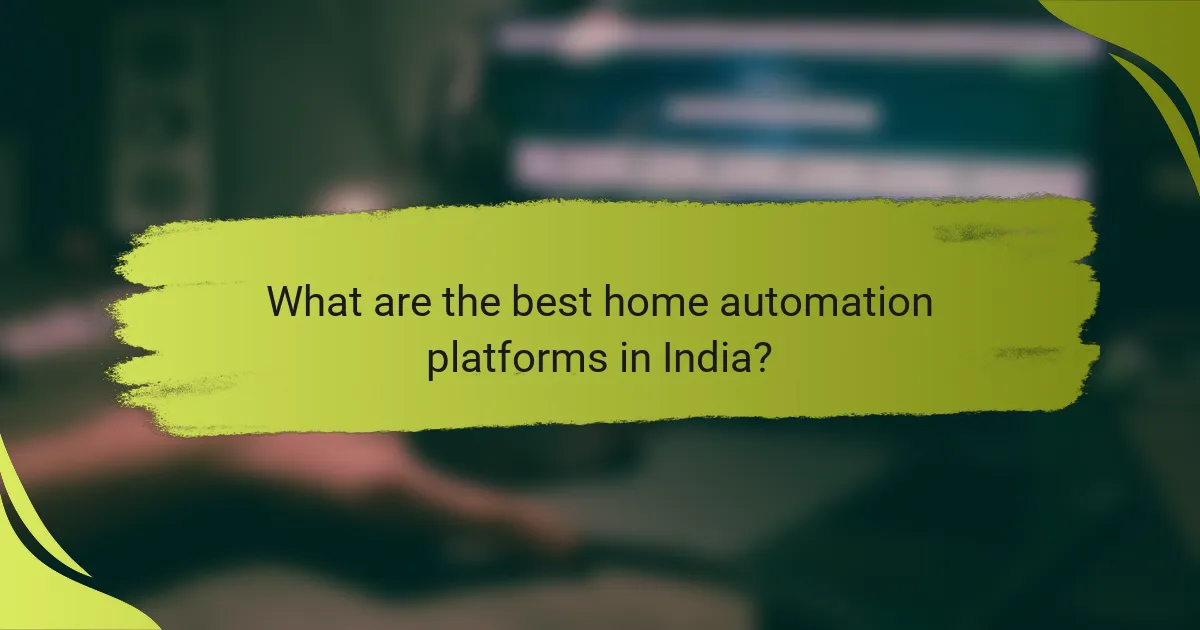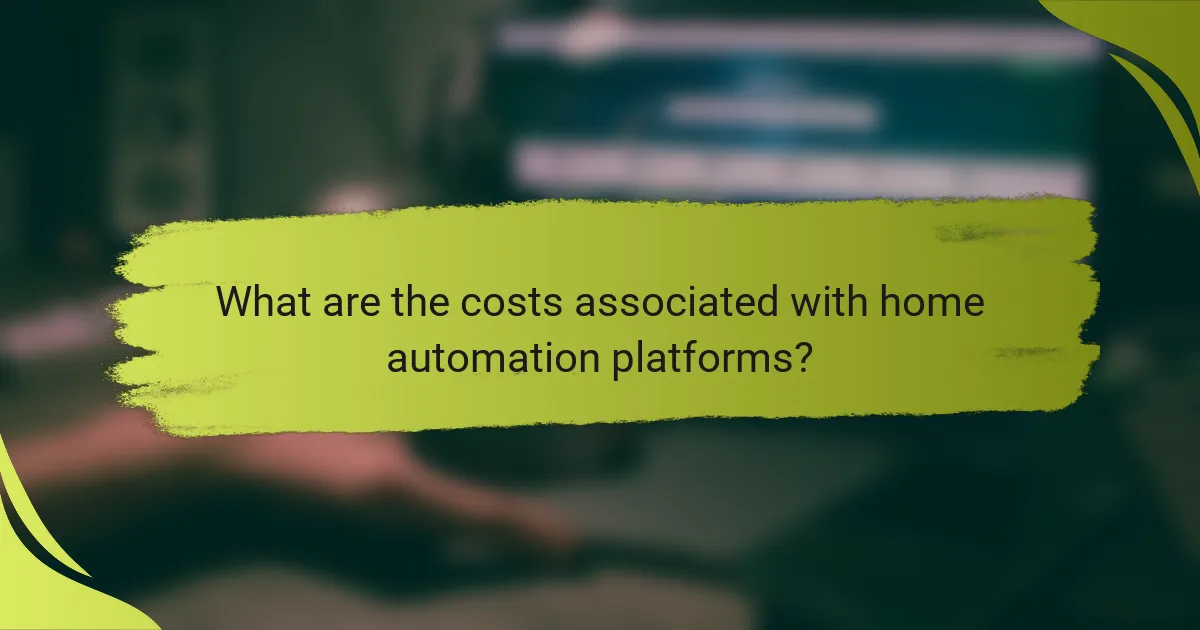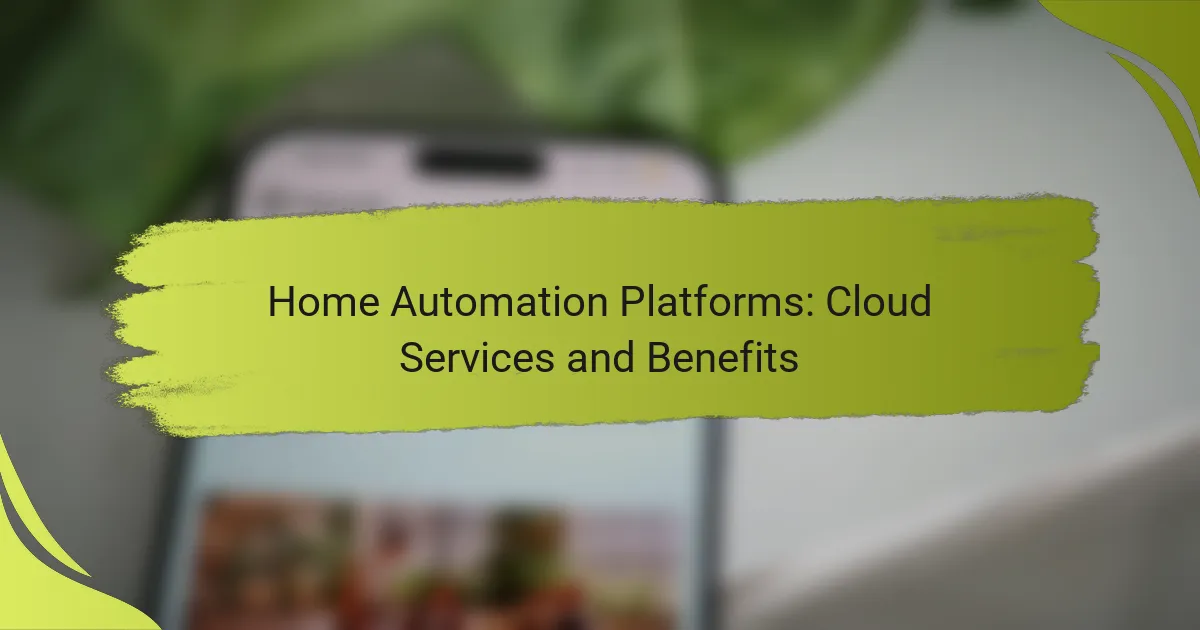Home automation platforms have revolutionized the way we interact with our living spaces, offering users the ability to control smart devices effortlessly. With options like Amazon Alexa, Google Nest, and Apple HomeKit, these platforms leverage cloud services to provide remote access, scalability, and enhanced security. Selecting the right platform involves considering device compatibility, user experience, and customer support to ensure a seamless integration into your home environment.

What are the best home automation platforms in India?
The best home automation platforms in India include Amazon Alexa, Google Nest, Apple HomeKit, Samsung SmartThings, and Wink Hub. These platforms offer various features and integrations that cater to different user needs, making it easier to control smart devices in a home environment.
Amazon Alexa
Amazon Alexa is a voice-controlled platform that allows users to manage smart home devices through voice commands. It supports a wide range of devices, making it versatile for different automation needs.
To get started, users need an Alexa-enabled device, such as an Echo speaker. Once set up, they can create routines, control lights, and even manage security systems with simple voice prompts.
Google Nest
Google Nest integrates seamlessly with Google Assistant, allowing users to control their smart home devices using voice commands or the Google Home app. It offers features like scheduling and automation for various devices.
Setting up Google Nest involves connecting compatible devices to the Google Home app. Users can create custom routines to automate tasks, such as adjusting the thermostat or turning off lights at bedtime.
Apple HomeKit
Apple HomeKit is designed for users within the Apple ecosystem, allowing control of smart devices through Siri or the Home app. It emphasizes security and privacy, making it a preferred choice for Apple users.
To use HomeKit, users need compatible devices and an Apple device to manage them. HomeKit supports automation through scenes and triggers, enabling users to create personalized experiences based on their routines.
Samsung SmartThings
Samsung SmartThings provides a robust platform for managing a variety of smart devices from different manufacturers. It allows users to create automations and monitor their home environment through a single app.
Users can start with a SmartThings Hub, which connects to compatible devices. The platform supports a wide range of integrations, making it suitable for users looking to build a comprehensive smart home system.
Wink Hub
Wink Hub is a user-friendly platform that supports multiple protocols, making it easy to connect various smart devices. It offers a simple interface for managing home automation tasks.
To use Wink Hub, users need to set up the hub and connect their devices via the Wink app. The platform allows for the creation of routines and automations, providing flexibility for different user preferences.

What benefits do cloud services offer for home automation?
Cloud services provide significant advantages for home automation, including remote access, scalability, enhanced security, and seamless integration with various devices. These benefits enable users to manage their home systems more efficiently and effectively from anywhere.
Remote access and control
Cloud services allow homeowners to control their automation systems from virtually anywhere, using smartphones or computers. This means you can adjust your thermostat, turn off lights, or monitor security cameras while away from home.
Many platforms offer mobile apps that provide real-time notifications and updates, ensuring you stay informed about your home’s status. This capability enhances convenience and peace of mind, especially for those with busy lifestyles.
Scalability and flexibility
Cloud-based home automation systems are highly scalable, allowing users to easily add or remove devices as needed. This flexibility means you can start with a few smart devices and expand your system over time without significant upfront investment.
As technology evolves, cloud services can accommodate new devices and features, ensuring your home automation system remains up-to-date. This adaptability is particularly beneficial for homeowners who want to customize their systems to fit changing needs.
Enhanced security features
Cloud services often come with advanced security features, such as data encryption and regular software updates. These measures help protect your home automation system from potential cyber threats, ensuring your personal information remains secure.
Many platforms also offer two-factor authentication and activity logs, allowing users to monitor access and detect any unauthorized attempts. This level of security is crucial for maintaining the integrity of your home automation setup.
Integration with third-party devices
Cloud services facilitate easy integration with a wide range of third-party devices, enhancing the functionality of your home automation system. This compatibility allows users to connect various brands and types of devices, creating a cohesive smart home environment.
For instance, you can integrate smart speakers, security cameras, and lighting systems, enabling them to work together seamlessly. This interoperability not only improves user experience but also maximizes the potential of your home automation investments.

How to choose a home automation platform?
Choosing a home automation platform involves assessing compatibility with your devices, evaluating the user interface, and considering the level of customer support available. A well-selected platform should seamlessly integrate with your existing technology while providing an intuitive experience and reliable assistance.
Evaluate compatibility with devices
Compatibility is crucial when selecting a home automation platform. Ensure the platform supports a wide range of devices, including smart lights, thermostats, security cameras, and appliances. Check for compatibility with popular protocols like Zigbee, Z-Wave, and Wi-Fi to avoid future limitations.
Before committing, review the manufacturer’s specifications and user reviews to confirm that your devices will work smoothly with the chosen platform. Some platforms may excel with specific brands, so consider your current device ecosystem.
Consider user interface and experience
The user interface (UI) and overall experience significantly impact how effectively you can manage your home automation system. Look for platforms that offer a clean, intuitive interface, allowing easy navigation and control of devices. A mobile app and web dashboard should provide similar functionalities for convenience.
Test out demo versions or user reviews to gauge the experience. Features like customizable dashboards, voice control compatibility, and automation routines can enhance usability and make daily interactions more efficient.
Assess customer support and community
Reliable customer support is essential for troubleshooting and maximizing your home automation experience. Investigate the support options available, such as live chat, email, or phone assistance, and check the hours of operation to ensure they align with your needs.
A strong user community can also provide valuable insights and troubleshooting tips. Look for forums, social media groups, or online resources where users share experiences and solutions. A vibrant community can enhance your understanding of the platform and help you resolve issues more quickly.

What are the costs associated with home automation platforms?
The costs associated with home automation platforms can vary significantly based on the complexity of the system and the specific services chosen. Key expenses include initial setup costs, ongoing subscription fees, and the price of compatible devices.
Initial setup costs
Initial setup costs for home automation platforms typically range from a few hundred to several thousand dollars. This expense often includes the installation of devices, configuration of the system, and any necessary upgrades to your home’s infrastructure, such as wiring or network enhancements.
When budgeting for setup, consider whether you will hire a professional installer or opt for a DIY approach. Professional installation can ensure proper integration and functionality but will increase your upfront costs.
Monthly subscription fees
Monthly subscription fees for home automation services generally range from around $5 to $50, depending on the features and level of support provided. Basic plans may offer limited functionality, while premium plans often include advanced features like cloud storage, remote access, and enhanced security options.
It’s essential to evaluate what each subscription plan includes to avoid paying for features you may not need. Some platforms may offer discounts for annual subscriptions, which can help reduce overall costs.
Cost of compatible devices
The cost of compatible devices can vary widely, with smart bulbs starting as low as $10 and advanced security cameras reaching several hundred dollars. When selecting devices, ensure they are compatible with your chosen home automation platform to avoid additional expenses.
Consider purchasing devices in bundles or kits, which can often provide savings compared to buying items individually. Additionally, keep an eye out for sales or promotions, as many retailers offer discounts on smart home products throughout the year.

What are the security risks of home automation platforms?
Home automation platforms can expose users to various security risks, primarily due to their reliance on internet connectivity and cloud services. These risks include unauthorized access, data breaches, and potential vulnerabilities in connected devices.
Unauthorized Access
Unauthorized access occurs when an individual gains control over your home automation system without permission. This can happen through weak passwords, outdated software, or unsecured networks. To mitigate this risk, use strong, unique passwords and enable two-factor authentication whenever possible.
Data Breaches
Data breaches can expose personal information stored in home automation systems, such as usage patterns and personal schedules. These breaches often result from inadequate security measures by service providers. Regularly review privacy settings and stay informed about any data protection regulations relevant to your region, such as GDPR in Europe.
Vulnerabilities in Connected Devices
Many connected devices may have inherent vulnerabilities due to poor design or lack of updates. These weaknesses can be exploited by hackers to gain control over your home network. Always keep device firmware updated and consider using a separate network for your smart devices to enhance security.
